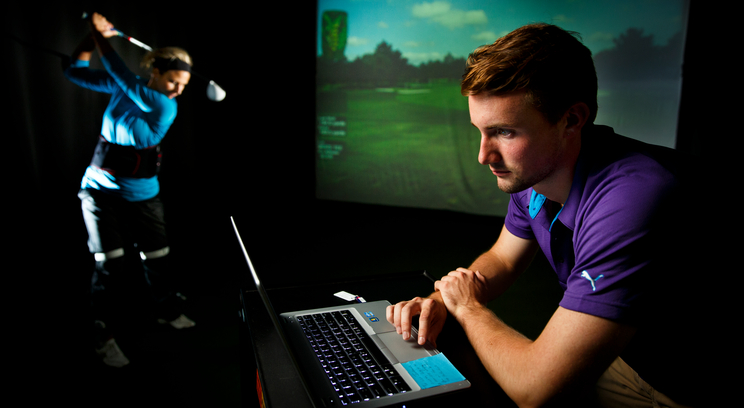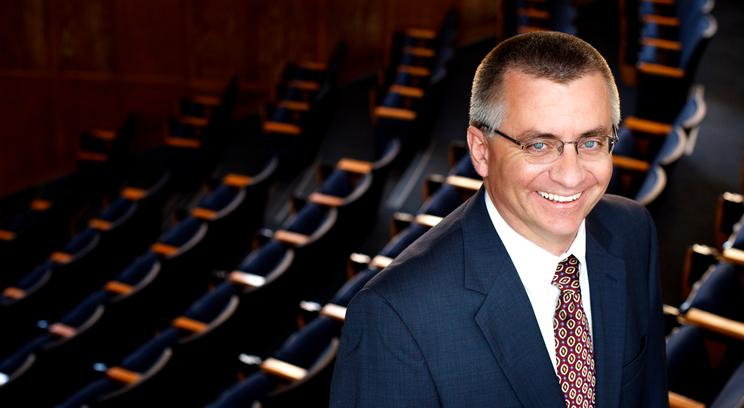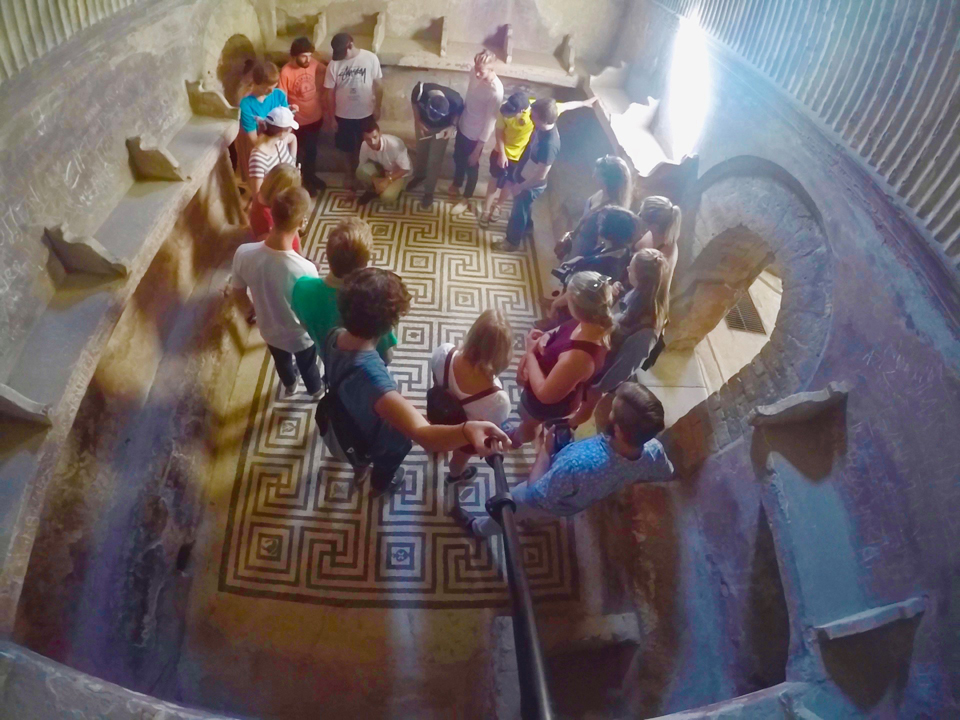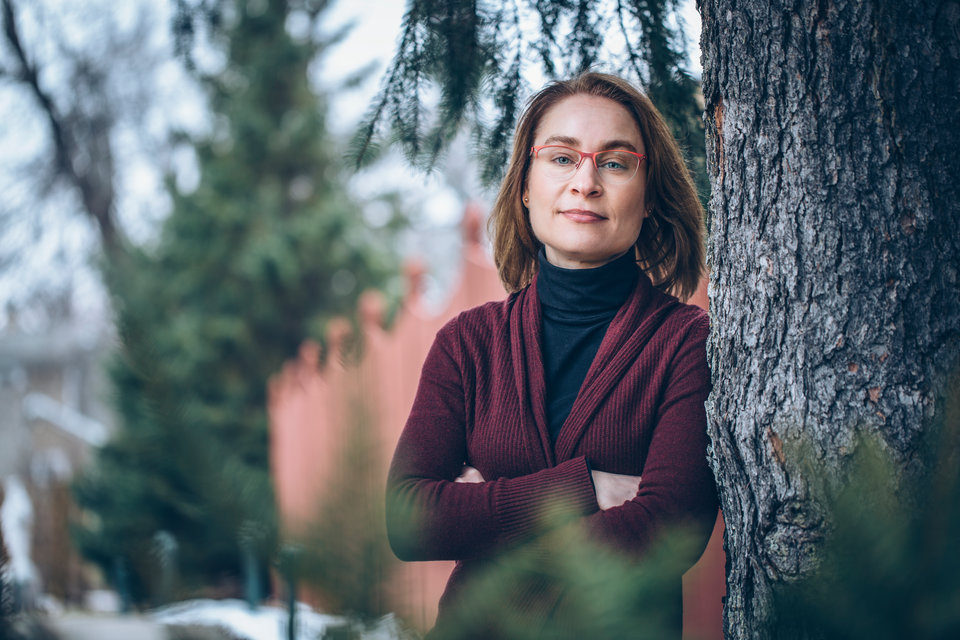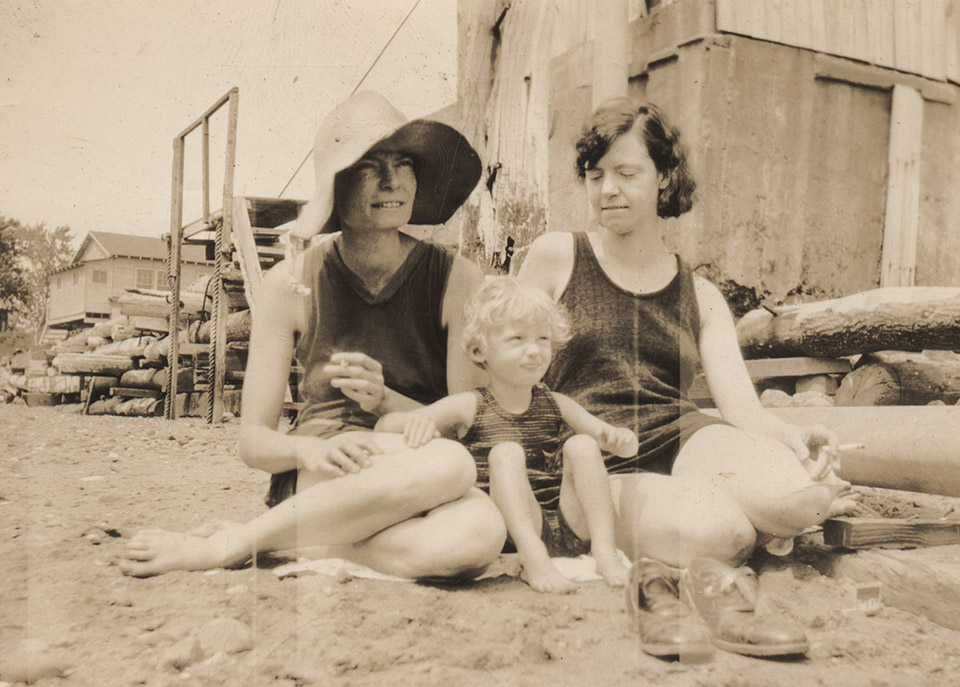If you had been passing by the biomechanics lab on the second floor of the Anderson Athletic and Recreation Complex on a recent cold April morning and glanced in the window, you might have stopped for a longer look. Students in that morning’s Kinesiology class sat at tables while perched on big blue stability balls. Most students gently moved back and forth and side to side atop the balls. A few students in the back row, however, bounced up and down a bit more enthusiastically, as they listened to a lecture about angle of muscle pull on bone.
Exercise science major and 2013 graduate Ann Goding could explain why the class was sitting on stability balls rather than sitting in chairs.
"Exercise both enlarges and increases plasticity of the hippocampus, allowing for increased neural activity and improved memory," Goding says. "While the positive effects of an active lifestyle on the brain are well-known, little research has assessed the immediate influence of low-intensity, long-endurance exercise on the memory of an individual. When chairs were replaced with stability balls in kindergarten classrooms, on-task behaviors and comprehension rates improved. College students have not been as extensively tested to determine the connection between exercise and cognitive function so the goal of this study was to investigate the relationship between low-intensity, long-duration exercise and cognitive function through the use of stability balls in the college population."
Goding’s research study is just one of many hands-on activities that take place during the academic year in the very busy Health and Human Performance Department. The current emphasis and increased level of student research is just one reflection of the many changes the department has experienced over the past five years.
Those changes include the development of five different yet related majors that focus on health and wellness, physical activity and exercise, as well as an explosion in the number of students selecting those majors, the hiring of new faculty, and a move into new classrooms and offices in the Anderson Athletic and Recreation Complex upon its opening.
"This department is not the old Physical Education Department from years past," says College of Arts and Sciences Dean Terence Langan. "While we are fortunate to be able to continue to educate future teachers of physical education and health education, as well as personal trainers and health club managers, as we always have, more and more students are coming to us to study exercise science. Students are finding it to be a good preparation for entry into professional study in the health sciences, including especially physical therapy and occupational therapy, among others. As a result, the department is becoming more science-oriented."
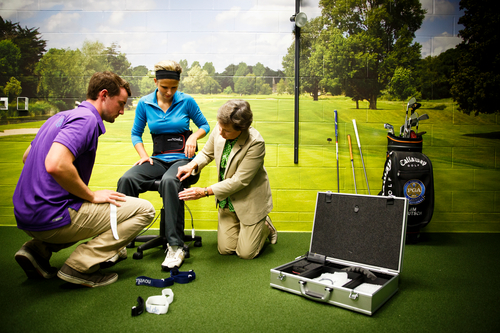
Andrew Eccles and Health and Human Performance professor Bridget Duoos help Kayla Westling put on the gear that will measure the pressure points on her feet during her golf swing. (Photo by Mark Brown)
The most popular of the department’s five majors is exercise science, which prepares students for careers in allied health-related fields or graduate school programs in areas such as physical therapy, athletic training, exercise physiology or biomechanics. The health promotion major readies students to work in the wellness and fitness industry or to enter occupational therapy graduate programs. The community health major prepares students for positions that deal with prevention of illness and disease or to seek a graduate degree in public health. Both the physical education and health education teaching majors train students to become certified K-12 teachers.
The exercise science major grew from 22 majors in 2003 to 160 in 2013. Drawing on allied course requirements in the departments of biology, chemistry and physics, HHP’s exercise science students also complete major field courses in kinesiology, biomechanics, exercise physiology, human anatomy and human physiology. All these courses are grounded in practical skills.
Robb Poutre, a 2013 exercise science graduate who intends to pursue a career as a physician, found that grounding useful.
"My favorite part of being an exercise science major at UST was the potential for practical application of everything I learned," Poutre says. "The human body is such an incredible thing, so resilient, intricate, adaptable, delicate and tough all at the same time. Acquiring the knowledge and learning the methods necessary to understand the function of the human body is truly an invaluable thing. The ability to understand the different aspects of the human body across broad health situations is a base of knowledge that I get excited about."
Not far behind exercise science in growth in number of majors is the health promotion major. This major jumped from 22 students in 2003 to 61 in 2013. One of the reasons for that increase has to do with career opportunities that now exist in the fitness industry. Programs that emphasize wellness, exercise and fitness for the elderly and the large baby-boomer populations that did not exist 25 years ago now are widespread and have created jobs for well-trained exercise science and health promotion majors.
While the Health and Human Performance Department has enjoyed the increase in number of students, the rapid growth has created challenges for the department, not least of which has been the need for more faculty. Adding urgency to this need was the unusual set of circumstances that engulfed the department from 2009 to 2011. In fall 2008, health educator John Rohwer was hired to serve as department chair and help longtime professors Dan Carey, an exercise physiologist, and Bridget Duoos, a biomechanist, move the department forward. Within two years, however, Carey was diagnosed with and died of a brain tumor, and Rohwer died in an accident.
"When John and Dan tragically died within a couple of months of each other it was a real blow to the department and to the College of Arts and Sciences," recalls Langan. "However, given the rapidly growing student demand for health and human performance classes we needed to move quickly to hire new faculty. We have been fortunate to hire four excellent new full-time faculty members in the past three years, along with some very good new part-time faculty members."
The department moved quickly in spring 2011 to hire Timothy Mead, who teaches physical education methodology courses, as well as personal health and wellness. His current research interest is in studying the effectiveness of exercise on the academic performance of school children. In his courses, Mead minimizes lecturing and emphasizes hands-on active learning, a practice that is increasingly a keystone for all of the department’s courses.
Jolynn Gardner joined the department in fall 2011, specializing in community health. Her areas of research include stress management, obesity, and coping with grief and loss. Gardner frequently uses a project-based approach in the courses she teaches since one challenging aspect of a public health career is translating scientific research into information and advice that are readily understood by community members. To practice this skill, Gardner’s students create blogs that translate current public health research into relevant, realistic information and advice for the public.
"Public health is an exciting, growing field, and the professional opportunities abound," Gardner says. "Public health is also very broad, so there are opportunities for virtually every student’s area of interest as well, whether it be obesity prevention, infectious disease control, drug abuse prevention, promotion of fitness or health care policy reform, to name just a few."
Paul Mellick began teaching exercise physiology courses in the department in fall 2012 and established a laboratory that allows him to pursue research into the hormonal regulation of glucose metabolism. His primary research involves high-intensity exercise such as sprinting, weight training or short-term exhaustive exercise and metabolism, and he studies how this type of exercise affects metabolism, specifically blood glucose regulation and insulin action. This includes the relationships between high-intensity exercise and diabetes as well as high-intensity exercise and performance-enhancement.
This fall, Lesley Scibora joined the department to teach human anatomy courses. Scibora’s areas of expertise include being a health care provider as a doctor of chiropractic and work as an exercise physiologist. Her primary research interests involve the interaction of body weight, physical activity and bone strength.
"I am interested in understanding what factors influence bone health in overweight and obese individuals, and how bone strength is affected by weight loss through traditional behavioral and surgical methods," Scibora says. "It is important to find ways for individuals to become physically active in ways that are sustainable and beneficial to both their bones and overall health."
Hiring well-qualified faculty has made it possible for the department to continue curricular revisions in all of its majors, a process that had been initiated in 2010 and will continue through spring 2014. Except for pre-professional physical and health teacher education majors who do a student teaching experience, all HHP majors now must complete a 100-hour internship experience that places them in a variety of career-related settings. Those internships range from working with a professional athletic team to assisting disabled individuals with training programs. Another curricular revision involves adding laboratory requirements to courses in biomechanics and advanced physiology that will have students actively engaged in learning and practicing skills with state-of-the-art equipment. The faculty believe that the addition of lab time to these courses will not only have an impact on students’ learning in the courses themselves but also will have the effect of expanding the scope and depth of the research that students conduct in the required exercise science research methods course.
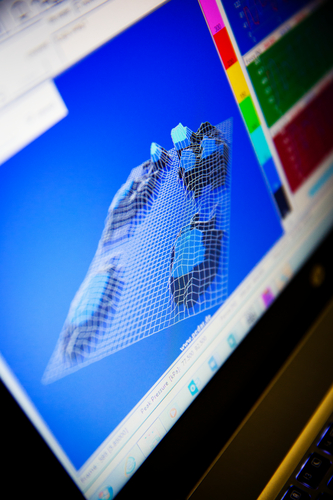
The equipment used by Eccles creates a 3D map of the pressure points of a golfer's feet, allowing careful analysis of how those pressure points affect a golf swing. (Photo by Mark Brown)
Helping to make lab requirements possible has been the commitment of the College of Arts and Sciences to provide funding to buy research-quality equipment. Peter Parilla, a longtime sociology professor and former associate dean who is currently serving as the department’s interim chair, says, "The increased emphasis on lab-based courses and on student research places added pressure on making sure that the department has state-of-the-art-research equipment. We are still building these resources but have made significant progress, thanks to the support of Dean Langan."
Several years ago the department purchased access to a sophisticated program called Anatomy TV. In laboratory classes in the human anatomy and human physiology courses, students are now able to do virtual cadaver dissection and access MRI, X-ray and CT scans through this program. Students can study the structure of bone from the inside out, add layers of muscles to a skeleton, rotate the structure and see the origin and insertion of the muscle. Students also can watch skeletons performing fundamental movements such as walking and sitting and see how a muscle functions throughout the movement. Students are further able to analyze movement in their kinesiology and biomechanics courses by using video cameras and motion analysis programs available to them. In the department’s computer lab, students can download video and then watch movements in slow motion, measure joint angles and provide feedback regarding the movement. Students can digitize movement to get velocities and accelerations of limbs and joint angles.
Another recent equipment addition to the department are pedar-x pressure insoles that can be slipped into any shoe, such as a running shoe, hockey skate or golf shoe, to measure pressure changes over the entire foot surface as a person progresses through a movement. This program can be synched with video to provide students an even more thorough analysis.
In the biomechanics lab, Nintendo Wii platforms and software from AgileMedicine allow students to learn how to measure postural sway in athletes who have experienced concussions. The exercise physiology lab added a treadmill and metabolic cart that allow students to learn how to conduct a maxVO2 test that determines the maximal amount of oxygen a person is able to consume and get to the working muscles during exercise. A freezer at minus 80º Celsius (minus 117.40º F) recently was added to the lab so blood and tissue variables can be studied and stored without degradation or metabolic activity.
The faculty eagerly anticipates the addition of the Bod Pod as well as the computed tomography (CT) machine next year. The Bod Pod uses whole-body densitometry to determine body composition of an individual. In approximately five minutes of sitting in the BodPod, the amount of fat and fat-free mass that makes up a person can be determined. The computed tomography machine will allow for an X-ray scan to be done of a body part. HHP faculty anticipates using it to determine the effect of exercise on bone.
"The enthusiasm that the faculty has for research has clearly been contagious," Parilla says. "Students are clearly motivated and excited to participate." The access to research-quality equipment makes it possible to engage larger numbers of students in conducting that research with real life applications.
If you were to visit the HHP department, you could work your way down the hallway and read student research posters that are the culminating results of research studies conducted in biomechanics and exercise science courses. While the exercise science major has a long history of conducting undergraduate research, the addition of dedicated faculty and research quality equipment means the department can help students conduct studies that can be presented at national conferences and submitted for publication in professional journals.
When Goding tested her fellow students sitting on the large stability balls in their Kinesiology class, she found they experienced slight improvements in reaction times but no improvement in verbal or visual memory, cognitive efficiency index or impulse control.
Duoos, a long-time proponent of student research, says, "Participating in such experiences in exercise science is virtually unheard of at the Division III undergraduate level. I am thrilled to see the addition of faculty and equipment to the program and am eagerly looking forward to the high level of research more students will be able to undertake."
The HHP faculty share that vision, imagining a day when the program will be recognized as a leading undergraduate program nationally. Scibora speaks for the faculty when she says, "We hope that students will continue to be drawn to the program because of excellent learning environments, from the classroom to hands-on experiences and high-level research opportunities that provide both the HHP department and its graduates a competitive edge."
Read more from CAS Spotlight.
